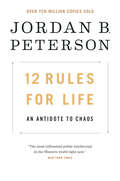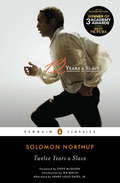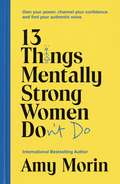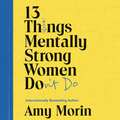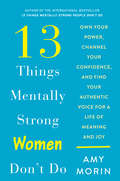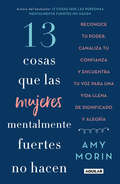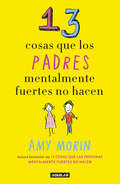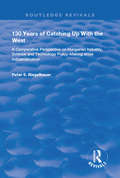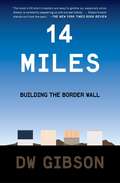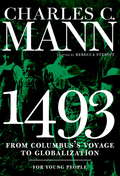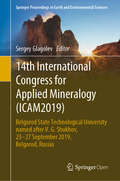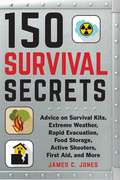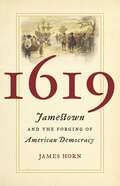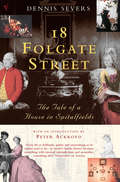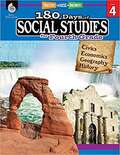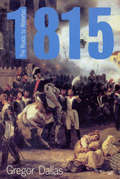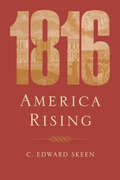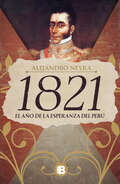- Table View
- List View
12 Rules for Life: An Antidote to Chaos
by Jordan B. PetersonWhat does everyone in the modern world need to know? Renowned psychologist Jordan B. Peterson's answer to this most difficult of questions uniquely combines the hard-won truths of ancient tradition with the stunning revelations of cutting-edge scientific research.Humorous, surprising and informative, Dr. Peterson tells us why skateboarding boys and girls must be left alone, what terrible fate awaits those who criticize too easily, and why you should always pet a cat when you meet one on the street. What does the nervous system of the lowly lobster have to tell us about standing up straight (with our shoulders back) and about success in life? Why did ancient Egyptians worship the capacity to pay careful attention as the highest of gods? What dreadful paths do people tread when they become resentful, arrogant and vengeful? Dr. Peterson journeys broadly, discussing discipline, freedom, adventure and responsibility, distilling the world's wisdom into 12 practical and profound rules for life. 12 Rules for Life shatters the modern commonplaces of science, faith and human nature, while transforming and ennobling the mind and spirit of its readers.
12 Years a Slave
by Ira Berlin Henry Louis Gates Solomon Northup Steve McqueenThe official movie tie-in edition to the winner of the 2014 Academy Award for Best Picture, starring Chiwetel Ejiofor, Michael Fassbender, and Lupita Nyong'o, and directed by Steve McQueen New York Times bestseller "I could not believe that I had never heard of this book. It felt as important as Anne Frank's Diary, only published nearly a hundred years before. . . . The book blew [my] mind: the epic range, the details, the adventure, the horror, and the humanity. . . . I hope my film can play a part in drawing attention to this important book of courage. Solomon's bravery and life deserve nothing less." --Steve McQueen, director of 12 Years a Slave, from the Foreword Perhaps the best written of all the slave narratives, Twelve Years a Slave is a harrowing memoir about one of the darkest periods in American history. It recounts how Solomon Northup, born a free man in New York, was lured to Washington, D.C., in 1841 with the promise of fast money, then drugged and beaten and sold into slavery. He spent the next twelve years of his life in captivity on a Louisiana cotton plantation. After his rescue, Northup published this exceptionally vivid and detailed account of slave life. It became an immediate bestseller and today is recognized for its unusual insight and eloquence as one of the very few portraits of American slavery produced by someone as educated as Solomon Northup, or by someone with the dual perspective of having been both a free man and a slave.
13 Things Mentally Strong Women Don't Do: Own Your Power, Channel Your Confidence, and Find Your Authentic Voice
by Amy MorinThe emergence of the #MeToo and #TimesUp movements have awakened society and encouraged women to find their voice and claim back their power. Contending with a host of difficult issues that demand psychological strength - in this crucial book, prominent psychotherapist and licensed clinical social worker Amy Morin gives women the techniques to build mental muscle in 13 steps.Delving into critical issues like sexism, social media, social comparison, and social pressure, Amy offers thoughtful, intelligent advice, practical tips, and specific strategies; combining them with her personal experiences, stories from former patients, and both well-known and untold examples from women from across industries and pop culture. Throughout, she explores the areas women - and society at large - must focus on to become (and remain) mentally strong.Amy reveals that healthy, mentally tough women don't insist on perfection; they don't compare themselves to other people; they don't see vulnerability as a weakness; they don't let self-doubt stop them from reaching their goals. Insightful, grounded, and extremely timely, 13 THINGS MENTALLY STRONG WOMEN DON'T DO can help every woman flourish - and Amy will take readers on this journey with her, every step of the way.
13 Things Mentally Strong Women Don't Do: Own Your Power, Channel Your Confidence, and Find Your Authentic Voice
by Amy MorinThe emergence of the #MeToo and #TimesUp movements have awakened society and encouraged women to find their voice and claim back their power. Contending with a host of difficult issues that demand psychological strength - in this crucial book, international bestselling author, prominent psychotherapist and licensed clinical social worker Amy Morin gives women the techniques to build mental muscle in 13 steps.Delving into critical issues like sexism, social media, social comparison, and social pressure, Amy offers thoughtful, intelligent advice, practical tips, and specific strategies; combining them with her personal experiences, stories from former patients, and both well-known and untold examples from women from across industries and pop culture. Throughout, she explores the areas women - and society at large - must focus on to become (and remain) mentally strong.Amy reveals that healthy, mentally tough women don't insist on perfection; they don't compare themselves to other people; they don't see vulnerability as a weakness; they don't let self-doubt stop them from reaching their goals. Insightful, grounded, and extremely timely, 13 THINGS MENTALLY STRONG WOMEN DON'T DO can help every woman flourish - and Amy will take readers on this journey with her, every step of the way.(P)2019 Harper Audio
13 Things Mentally Strong Women Don't Do: Own Your Power, Channel Your Confidence, and Find Your Authentic Voice for a Life of Meaning and Joy
by Amy MorinIn the time of the #MeToo and #TimesUp movement, international bestselling author and leading global expert on mental strength Amy Morin turns her focus to feminism, explaining what it means—and what it takes—to be a mentally strong woman.The emergence of the #MeToo and #TimesUp movements have awakened society and encouraged women to find their voice and claim their power. But to do this, women must learn to improve their own mental strength. Contending with a host of difficult issues—from sexual assault on college campuses, to equal pay and pay gaps, to mastering different negotiation styles—demands psychological toughness. In this crucial book, prominent psychotherapist and licensed clinical social worker Amy Morin gives women the techniques to build mental muscle—and just as important, she teaches them what not to do. What does it mean to be a mentally strong woman? Delving into critical issues like sexism, social media, social comparison, and social pressure, Amy addresses this question and offers thoughtful, intelligent advice, practical tips, and specific strategies and combines them with personal experiences, stories from former patients, and both well-known and untold examples from women from across industries and pop culture. Throughout, she explores the areas women—and society at large—must focus on to become (and remain) mentally strong. Amy reveals that healthy, mentally tough women don’t insist on perfection; they don’t compare themselves to other people; they don’t see vulnerability as a weakness; they don’t let self-doubt stop them from reaching their goals. Wise, grounded, and essential, 13 Things Mentally Strong Women Don’t Do can help every woman flourish—and ultimately improve our society as well.
13 cosas que las mujeres mentalmente fuertes no hacen
by Amy MorinAutora del bestseller 13 cosas que las personas mentalmente fuertes no hacen. RECONOCE TU PODER, CANALIZA TU CONFIANZA Y ENCUENTRA TU VOZ PARA UNA VIDA LLENA DE SIGNIFICADO Y ALEGRÍA. ¿Qué significa ser una mujer mentalmente fuerte? La aparición de los movimientos #MeToo y #TimesUp ha despertado a la sociedad y ha alentado a las mujeres a encontrar su voz y reclamar su poder. Pero para hacer esto, las mujeres deben aprender a mejorar su propia fuerza mental. Contender con una serie de problemas difíciles, desde la igualdad salarial hasta la agresión sexual, exige dureza psicológica. En este libro crucial, la reconocida psicoterapeuta Amy Morin les enseña a las mujeres cómo fortalecerse y enfrentar los desafíos a través de 13 hábitos y estados mentales que las mujeres deben evitar para dominar su fuerza mental. Estos 13 principios probados les muestran a las mujeres cómo enfrentar problemas y situaciones difíciles para vivir sus mejores y más poderosas vidas. Con base en evidencias científicas y estudios de casos de sus propios pacientes, Amy muestra cómo la fortaleza mental puede provenir de cualquier parte, independientemente de tu carrera, tu situación social, tu matrimonio o tu vida familiar. ¡Alcanza tu fortaleza mental para crear una vida de auténtico significado y alegría!
13 cosas que las mujeres mentalmente fuertes no hacen
by Amy MorinAutora del bestseller 13 cosas que las personas mentalmente fuertes no hacen. RECONOCE TU PODER, CANALIZA TU CONFIANZA Y ENCUENTRA TU VOZ PARA UNA VIDA LLENA DE SIGNIFICADO Y ALEGRÍA. ¿Qué significa ser una mujer mentalmente fuerte? La aparición de los movimientos #MeToo y #TimesUp ha despertado a la sociedad y ha alentado a las mujeres a encontrar su voz y reclamar su poder. Pero para hacer esto, las mujeres deben aprender a mejorar su propia fuerza mental. Contender con una serie de problemas difíciles, desde la igualdad salarial hasta la agresión sexual, exige dureza psicológica. En este libro crucial, la reconocida psicoterapeuta Amy Morin les enseña a las mujeres cómo fortalecerse y enfrentar los desafíos a través de 13 hábitos y estados mentales que las mujeres deben evitar para dominar su fuerza mental. Estos 13 principios probados les muestran a las mujeres cómo enfrentar problemas y situaciones difíciles para vivir sus mejores y más poderosas vidas. Con base en evidencias científicas y estudios de casos de sus propios pacientes, Amy muestra cómo la fortaleza mental puede provenir de cualquier parte, independientemente de tu carrera, tu situación social, tu matrimonio o tu vida familiar. ¡Alcanza tu fortaleza mental para crear una vida de auténtico significado y alegría!
13 cosas que los padres mentalmente fuertes no hacen
by Amy MorinDescubre cómo criar niños seguros y con autoestima entrenando sus cerebros para una vida de felicidad, significado y éxito. ¿Evitas que tu hijo cometa errores? ¿Le das a tu hijo poder sobre ti? ¿Eres padre por culpa? Si es así, no estás solo. Todos los padres quieren brindar a sus hijos el mejor y más seguro futuro. Pero en un mundo cada vez más complicado, muchos padres han llevado las cosas demasiado lejos, creyendo erróneamente que darles a sus hijos la mejor oportunidad de una vida exitosa implica tratar de protegerlos del dolor y la realidad. Muchas de las prácticas de crianza populares de hoy en día no permiten que los padres enseñen a los niños las habilidades que necesitan para convertirse en adultos mentalmente fuertes. Como psicoterapeuta, experta en terapia familiar y para adolescentes, y madre adoptiva, Amy ha sido testigo de primera mano de qué funciona. Cuando los niños tienen las habilidades que necesitan para enfrentar los desafíos en su vida cotidiana, prosperan social, emocional, conductual y académicamente. Amy combina estudios de casos, consejos prácticos, estrategias específicas y ejercicios probados para ayudar a niños de todas las edades; desde preescolares hasta adolescentes, a construir mentes fuertes para convertirse en adultos sanos. Padres mentalmente fuertes crían hijos mentalmente fuertes.
130 Years of Catching Up with the West: A Comparative Perspective on Hungarian Science and Technology Policy-making Since Industrialization (Routledge Revivals)
by Peter S BiegelbauerThis title was first published in 2000: Issues such as globalization and the fight against joblessness as well as the growth dynamics of economies in general have been linked with science and technology. Accordingly, the growing public interest in the effects of science and technology on society and politics and vice versa have been the foremost reason for the creation of this study. One of the central questions for politicians as well as for scholars in the field of science and technology is, "How can I influence a given science and technology system in a way so as to achieve optimal outcomes for a given national economy?". The study at hand tries to answer this question by analyzing the Hungarian research sphere from industrialization until the late-20th century. Since the beginning of industrialization, Hungary has made a number of attempts to catch up with the economically more developed Western European countries. The problems encountered in the course of the Hungarian efforts are surprisingly similar to the difficulties that modern, fully industrialized economies are facing today.
1381: The Year of the Peasants' Revolt
by Juliet BarkerJuliet Barker provides an account of the first great popular uprising in England and a fascinating study of medieval life in English towns and countryside. She tells how and why an unlikely group of ordinary men and women from every corner of England united in armed rebellion against church and state to demand a radical political agenda.
14 Miles: Building the Border Wall
by DW GibsonAn esteemed journalist delivers a compelling on-the-ground account of the construction of President Trump&’s border wall in San Diego—and the impact on the lives of local residents.In August of 2019, Donald Trump finished building his border wall—at least a portion of it. In San Diego, the Army Corps of engineers completed two years of construction on a 14-mile steel beamed barrier that extends eighteen-feet high and cost a staggering $147 million. As one border patrol agent told reporters visiting the site, &“It was funded and approved and it was built under his administration. It is Trump&’s wall.&” 14 Miles is a definitive account of all the dramatic construction, showing readers what it feels like to stand on both sides of the border looking up at the imposing and controversial barrier. After the Department of Homeland Security announced an open call for wall prototypes in 2017, DW Gibson, an award-winning journalist and Southern California native, began visiting the construction site and watching as the prototype samples were erected. Gibson spent those two years closely observing the work and interviewing local residents to understand how it was impacting them. These include April McKee, a border patrol agent leading a recruiting program that trains teenagers to work as agents; Jeff Schwilk, a retired Marine who organizes pro-wall rallies as head of the group San Diegans for Secure Borders; Roque De La Fuente, an eccentric millionaire developer who uses the construction as a promotional opportunity; and Civile Ephedouard, a Haitian refugee who spent two years migrating through Central America to the United States and anxiously awaits the results of his asylum case. Fascinating, propulsive, and incredibly timely, 14 Miles is an important work that explains not only how the wall has reshaped our landscape and countless lives but also how its shadow looms over our very identity as a nation.
1493 for Young People
by Rebecca Stefoff Charles Mann1493 for Young People by Charles C. Mann tells the gripping story of globalization through travel, trade, colonization, and migration from its beginnings in the fifteenth century to the present. How did the lowly potato plant feed the poor across Europe and then cause the deaths of millions? How did the rubber plant enable industrialization? What is the connection between malaria, slavery, and the outcome of the American Revolution? How did the fabled silver mountain of sixteenth-century Bolivia fund economic development in the flood-prone plains of rural China and the wars of the Spanish Empire? Here is the story of how sometimes the greatest leaps also posed the greatest threats to human advancement.Mann's language is as plainspoken and clear as it is provocative, his research and erudition vast, his conclusions ones that will stimulate the critical thinking of young people. 1493 for Young People provides tools for wrestling with the most pressing issues of today, and will empower young people as they struggle with a changing world.From the Hardcover edition.
14th International Congress for Applied Mineralogy: Belgorod State Technological University named after V. G. Shukhov, 23–27 September 2019, Belgorod, Russia (Springer Proceedings in Earth and Environmental Sciences)
by Sergey GlagolevThis open access proceedings of the 14th International Council for Applied Mineralogy Congress (ICAM) in Belgorod, Russia cover a wide range of topics including applied mineralogy, advanced and construction materials, ore and industrial minerals, mineral exploration, cultural heritage, etc. It includes contributions to geometallurgy, industrial minerals, oil and gas reservoirs as well as stone artifacts and their preservation. The International Congress on Applied Mineralogy strengthens the relation between the research on applied mineralogy and the industry.
15 Ways to Stay Alive
by Daphne GottliebBroken hearts, scattered dreams, postpunk politics, and postmodern cut-up collages spiral and flow in award-winning poet Daphne Gottlieb's latest collection of startling new works that explore survival after personal or communal disasters and the renewal that follows. Whether she's writing about unanticipated outcomes ("After the Midway Ride Collapsed"), her mother's passing ("Somewhere, Over"), or absurd situations ("Preoccupation"), Gottlieb's deeply personal insights into the complex areas where life and contemporary culture collide offer readers a unique, thought-provoking perspective."I Have Always Confused Desire with Apocalypse"We met over a smallearthquake. Now, my kneesshake wheneveryou come aroundand I've noticed your handhas a slight tremor.Daphne Gottlieb is the award-winning author of seven books including the critically acclaimed poetry collection Final Girl (Soft Skull Press) and the graphic novel Jokes and the Unconscious (Cleis Press), illustrated by Diane DiMassa. Gottlieb has performed and taught creative writing workshops throughout the United States. She received her MFA from Mills College, and currently resides in San Francisco.
150 Survival Secrets: Advice on Survival Kits, Extreme Weather, Rapid Evacuation, Food Storage, Active Shooters, First Aid, and More
by James C. JonesAs the world gets more dangerous, you have to be prepared for anything, even the worst. In 150 Survival Secrets, seasoned survivalist James C. Jones provides insider tips to help you and your family survive any catastrophe. Divided into practical sections, 150 Survival Secrets answers every question you’ve ever had about disaster preparedness. One section lists the practical details of making it through any kind of emergency situation. Some topics include: How to survive extreme winter conditionsHow to put together a homemade survival kit in the case of an emergencyHow to safely evacuate from an urban area during a disasterHow much and what type of food to store at home for long-term emergenciesHow to survive an active shooter situationHow to treat common injuries. Other sections answer everything you’ve ever wondered about disaster prepping, including what being a survivalist entails, how to equip your home for survival situations, what gear is essential for a survivalist to own, what elements are essential in a good emergency plan, what types of disasters you can expect to face in your lifetime, and more. So what are you waiting for? With 150 Survival Secrets, you’ll be prepared for anything and everything.
1545: Who Sank The Mary Rose?
by Peter MarsdenA &“wonderful&” account of the raising of a sixteenth-century warship, and answers to the long-running mysteries surrounding her loss (Naval Historical Foundation). In 1982, a Tudor Navy warship was raised in a major salvage project that represented a landmark in maritime archaeology. The Mary Rose had spent over four centuries underwater, and contained the skeletons of numerous sailors as well as many fascinating artifacts of the time. She is more than a relic, however. She has a story to tell, and her sinking in the Solent while under attack by the French, and the reasons for it, have intrigued historians for generations. With the benefit of access to her remains, archaeologists have been able to slowly unravel the mystery of her foundering on a calm summer&’s day in July 1545. This new book by a leading expert on the Mary Rose contains much information that is published for the first time. It provides the first full account of the battle in which Henry VIII&’s warship was sunk, and tells the stories of the English and French admirals. It examines the design and construction of the ship and how she was used, and finally makes clear who was responsible for the loss of the Mary Rose, after describing what happened onboard, deck by deck, in her last moments afloat. Includes photographs
15th International Scientific Conference on Distance Learning in Applied Informatics: DiVAI 2024 (EAI/Springer Innovations in Communication and Computing)
by Milan TurčániThe book presents the proceedings of the 15th DIVAI (Distance Learning in Applied Informatics) Conference, an international scientific event that focuses on the field of distance learning in applied informatics. The 15th edition of the conference took place from September 30 to October 2, 2024. The conference is held under the patronage of the Dean of the Faculty of Natural Sciences and Informatics, Constantine the Philosopher University in Nitra. The proceedings are relevant to researchers, academics, professionals, and students in distance learning and applied informatics.
1619: Jamestown and the Forging of American Democracy (Published By The Omohundro Institute Of Early American History And Culture And The University Of North Carolina Press Ser.)
by James HornAn extraordinary year in which American democracy and American slavery emerged hand in handAlong the banks of the James River, Virginia, during an oppressively hot spell in the middle of summer 1619, two events occurred within a few weeks of each other that would profoundly shape the course of history. In the newly built church at Jamestown, the General Assembly--the first gathering of a representative governing body in America--came together. A few weeks later, a battered privateer entered the Chesapeake Bay carrying the first African slaves to land on mainland English America.In 1619, historian James Horn sheds new light on the year that gave birth to the great paradox of our nation: slavery in the midst of freedom. This portentous year marked both the origin of the most important political development in American history, the rise of democracy, and the emergence of what would in time become one of the nation's greatest challenges: the corrosive legacy of racial inequality that has afflicted America since its beginning.
17 Ziele für eine lebenswerte Zukunft: Für uns und für unsere Kinder
by Matthias MedertVielleicht machst auch du dir Sorgen darüber, wohin die vielen ökologischen und sozialen Probleme führen werden, von welcher Art und Ausmaß die Konsequenzen sein können und wie diese das Leben von Menschen betreffen werden? Dann könnte dieses Buch interessant für Dich sein: Es beschreibt anhand der 17 UN-Nachhaltigkeitsziele eine Vision für eine lebenswerte Zukunft. Du erfährst kurz und verständlich zu jedem der Ziele konkrete Hintergründe, Zusammenhänge und Herausforderungen, die es auf dem Weg dorthin noch zu meistern gilt. Es macht die Themen greifbar - sowohl global als auch bezogen auf Deutschland. Gleichzeitig liefert Dir das Buch Anregungen, wie Du selbst dazu beitragen kannst, die großen Probleme der Menschheit zu lösen: Klimawandel, Energie, Plastikmüll, Artenvielfalt, Umweltschutz, Hunger, Armut, etc.Zusammen können wir es schaffen, die 17 Ziele umzusetzen, indem wir sie mit konkreten Inhalten füllen. Falls uns das gelingt fragen unsere Kinder vielleicht eines Tages: „Wie habt ihr damals die Erde gerettet und die Menschheit in das Zeitalter der sozialen Gerechtigkeit geführt?“
1787: A Novel
by Joan AndersonAs James Madison's aide during the 1787 Constitutional Convention in Philadelphia, young Jared Mifflin experiences a summer filled with adventure, intrigue, and romance. The story of a teenager who became James Madison's aide during the 1787 Constitutional Convention in Philadelphia.
18 Folgate Street: The Life of a House in Spitalfields
by Dennis SeversGrowing up in California, Dennis Severs fell in love with the England he saw in old black and white movies. At seventeen he came to London, looking for a home with a heart. In 1979 he found one, a run-down silk-weaver's house in Spitalfields, and over the next twenty years he transformed it into an enchanted time-capsule, transporting us back to the eighteenth century. From cellar to roof, he filled 18 Folgate Street with original objects and furniture, found in the local markets, lit by candles and chandeliers. More than that, he invented a family to live here, the Jervis family, Huguenot weavers who fled persecution in France in 1688, and bought the house in 1724. Sounds and scents bring their world to life, always just out of sight - floorboards creak, fires crackle, a kettle hisses on the hob. Visitors step through the frame of time, like entering an old master painting. As we move from room to room on a tour you will never forget, we follow the Jervis story from the days of the Georges and the Regency to harsher Victorian times - and even to the attic room of Scrooge himself.
180 Days Of Social Studies For Fourth Grade: Civics, Economics, Geography, History
by Shell Education Staff Margaret WilliamsonSupplement your social studies curriculum with 180 days of daily practice! This essential classroom resource provides teachers with weekly social studies units that build students' content-area literacy, and are easy to incorporate into the classroom. Students will analyze primary sources, answer text-dependent questions, and improve their grade-level social studies knowledge. Each week covers a particular topic within one of the four social studies disciplines: history, economics, civics, and geography. Aligned to the National Council for the Social Studies (NCSS) and state standards, this resource includes digital materials.
1815: The Roads to Waterloo
by Gregor DallasThe seventeen months from April 1814 to August 1815 were an extraordinary period in European history; a period which saw two sieges of Paris, a complete revision of Europe's political frontiers, an international Congress set up in Vienna, civil war in Italy and international war in Belgium.Gregor Dallas tells the story of these days through the perspectives of three very different European cities: the great metropolis of London, post-revolutionary Paris and baroque Vienna. The writing is almost cinematic in its power to evoke and bring to life the Europe of Tolstoy: the ebb and flow of power, of armies and of peoples across Europe's northern plains. Working essentially from primary sources, Dallas is as interested in the weather conditions before battle as in the way cartoonists reacted to court intrigues and fashions.It is also Europe seen through the eyes of its central players: Talleyrand, who has served nearly every French regime since the Revolution of 1789; Metternich, who devises new plans for a 'Germany' that does not yet exist and for a 'Europe' that remains devided; Wellington, who reveals himself a diplomat as well as a soldier; Tsar Alexander, an idealist seeking to impose a uniform plan for all Europe; and 'Boney' himself, who has his own ideal of Europe and, though banished to Elba, does not abandon his dream to realise it.
1816: America Rising
by C. Edward Skeen“Makes the case for 1816 as an important year in the development of the American nation. Well-written and -researched . . . recommended.”—Library JournalThe year 1816 found America on the cusp of political, social, cultural, and economic modernity. Celebrating its fortieth year of independence, the country’s sense of self was maturing. Americans, who had emerged from the War of 1812 with their political systems intact, embraced new opportunities. For the first time, citizens viewed themselves not as members of a loose coalition of states but as part of a larger union. This optimism was colored, however, by bizarre weather. Periods of extreme cold and severe drought swept the northern states and the upper south throughout 1816, which was sometimes referred to as “The Year Without a Summer.” In 1816 , historian C. Edward Skeen illuminates this unique year of national transition. Politically, the “era of good feelings” allowed Congress to devise programs that fostered prosperity. Social reform movements flourished. This election year found the Federalist party in its death throes, seeking cooperation with the nationalistic forces of the Republican party. Movement west, maturation of political parties, and increasingly contentious debates over slavery characterized this pivotal year. 1816 marked a watershed in American history. This provocative book vividly highlights the stresses that threatened to pull the nation apart and the bonds that ultimately held it together.“Reveals a sense of the fragility of the American experiment.” —Boston Globe“Skeen narrates the major events of [the era’s] opening 12 months with great skill . . . with clarity and verve.” —Publisher’s Weekly“A very impressive exposition of political culture in the early republic.” —Andrew Burstein, author of Jefferson’s Secrets
1821: El año de la esperanza del Perú
by Alejandro NeyraEn 1821, Alejandro Neyra relata los episodios fundamentales de aquel año decisivo que cambió el rumbo de nuestra historia. ¿Cómo se originó la gesta por la Independencia del Perú? ¿Quiénes fueron los personajes que diseñaron las estrategias y las negociaciones para acabar con el virreinato e instaurar la República? En 1821, Alejandro Neyra relata los episodios fundamentales de aquel año decisivo que cambió el rumbo de nuestra historia. Este libro narra las comunicaciones y los encuentros entre el marqués de Torre Tagle y don José de San Martín y sus huestes para formar una alianza con la única misión de luchar por la libertad. Conspiraciones, acuerdos fallidos y amistades sólidas se encuentran en las páginas de este libro. Neyra da vida a los protagonistas de esta historia en cuyos diálogos descubrimos un profundo deseo de justicia y de cambio en la vida social, marcada por el temor de hallarse entre dos bandos y la necesidad de escoger uno de ellos. En 1821 destaca la participación de Rosa Campusano, Carmen Guzmán, Mariana Echevarría y Basil Hall, entre otros personajes que contribuyeron a la Independencia y a los que, cumplido el Bicentenario, este libro busca dar justo homenaje. «1821 nos muestra cómo se vivió la Independencia en el norte del Perú y en Lima, llena de color la historia que conocemos y nos ayuda a imaginar lo que dijeron y vivieron sus protagonistas». Natalia Sobrevilla Perea
